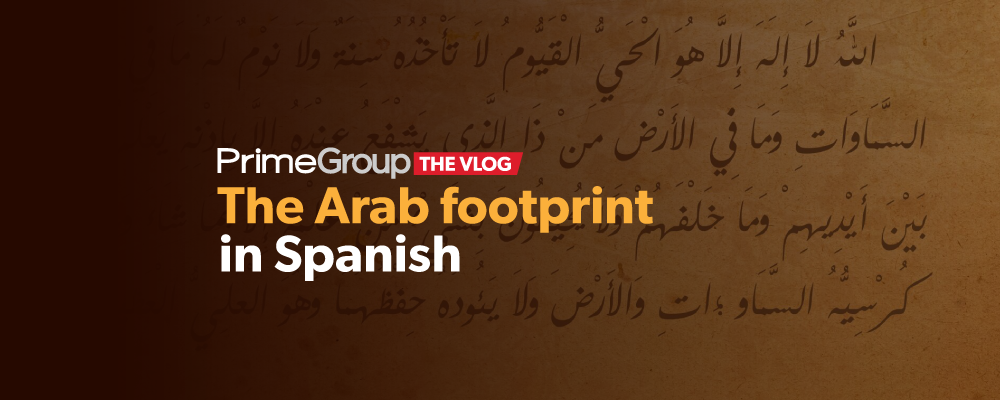According to linguists, 73% of the Spanish vocabulary is attributed to Latin. The rest comes from other languages, including peninsular languages. There are also words of Germanic, French, and English origin, as well as words from American languages such as Quechua and Nahuatl. But, surprisingly, 8% of our words have Arabic roots.
The Arabic Footprint in Castilian
Philologist Rafael Lapesa estimates that some 4,000 words in Castilian come from Arabic. (al… alacena, almance) This should not surprise us, given that the Arabs were present in the Iberian Peninsula for almost 800 years. It is important to clarify that the Muslim invasion was primarily a military and political occupation, which lasted from 711 to 1612. Although the last Muslim kingdom, that of Granada, was conquered in 1492, the Arabic-speaking Moorish communities, especially in Aragon and Valencia, remained until 1612, when they were finally expelled.
A genetic study by the University of Granada reveals that the Spanish population, like that of Italy, Greece and the south of France, has only 5% of North African or Middle Eastern origin. This suggests that, despite 800 years of Arab presence, there was little genetic mixing due to religious differences. The Islamic religion and Christianity had strict rules on marriage and cohabitation between people of different religions, which limited unions between Arabs and Christians. This religious and social segregation largely prevented miscegenation.
However, the Arabs left a lasting legacy in our culture, architecture (Moorish tower), science, literature (algebra) and of course, language. The arrival of the Arabs brought about a great cultural transformation. Al-Andalus, which was the Arabic term for the Iberian Peninsula, became a center of knowledge where classical Greek and Roman works were translated into Arabic, and important advances were made in mathematics, astronomy, medicine and philosophy. Figures such as Averroes and Maimonides, although the latter was Jewish, worked in a highly developed cultural environment.
Jarchas and Literature
In literature, jarchas stand out, short lyrical compositions written in Mozarabic (a Romance language influenced by Arabic). These jarchas appeared at the end of longer poems in Arabic or Hebrew. They represent one of the first forms of Spanish lyric poetry and are a testament to the rich cultural interaction in al-Andalus.
The Arabic Influence on Language
Arabic became the official language and a cultural language, coexisting with the Hispanic Romance language, known as Mozarabic. This bilingualism lasted for several centuries, leaving a deep mark on the Spanish lexicon.
In our daily lives, we use many words that are the legacy of this historical contact. For example, in the kitchen, we have words like “oil” and “olive.” If you like to cook, you have surely used “sugar” and “saffron,” both of Arabic origin. Even “rice” comes from Arabic.
The impact is not limited only to food. Think in terms of architecture and construction, such as “mason” and “alcázar,” which also have their roots in Arabic. And speaking of buildings, you have surely heard of the “Alhambra” (a place, a site, a building) in Granada, whose name means “the red one” in Arabic.
Another field where Arabic left its mark is in geography, toponymy. Many places in Spain have names of Arabic origin. For example, “Guadalquivir” comes from “al-wadi al-kabir”, which means “the great river”. “Almería” comes from “al-meraya”, which means “watchtower” or “observation tower”. And “Guadalajara” comes from “wādī al-ḥijārah”, which means “river of stones”. Oh, and if you are from Extremadura or Mexico, Guadalupe is a hybrid. Wadi, which means river, and lupe, which comes from the Latin lupus or wolf, meaning River Wolf.
The Arabic influence also affected the structure of our language to a lesser extent. For example, the word “hasta” is the only preposition of Arabic origin in Spanish. Although there are not many verbs of Arabic origin, the influence on nouns and adjectives is notable. On the other hand, in Spanish we use the prefix “al-” in many words, such as “almohada”, “almacén” and “alfombra”.
More examples? “ojalá” comes from “inshalla”, which means “God willing”. Or “acequia”, which is an irrigation canal. Also “barrio”, which comes from the Arabic “barriya”, which means “outside” or “suburb”.
The Arabic Legacy in Other Romance Languages
The Arabic influence in Italian, Portuguese, Catalan and French is notable in various linguistic aspects due to centuries of cultural and commercial interaction. In Italian, we find words like “zucchero” (sugar) and “limone” (lemon) or “cotone” (cotton), which reflect contributions in gastronomy and natural sciences. In Portuguese, terms like “azeite” (olive oil) and “alfandega” (customs) have Arabic roots, showing influences in food and trade. Catalan incorporates words like “arròs” (rice) and “taronger” (orange tree), evidencing contributions in agriculture and botany. In French, words like “chiffre” (cipher) and “jardin” (garden) reveal influences in scientific and domestic fields. “Tubibe” is a French term of Arabic origin meaning “physician” or “doctor.” In French, too, the Arabic word “backshish” is used to designate a tip, gratuity, or bribe, depending on the context.
In short, the Arabic legacy in Spanish and other Romance languages runs deep and is reflected in many facets of our daily lives. From cuisine to geography, architecture and language, Arabisms are an integral part of our European culture. So, the next time you enjoy a bowl of saffron rice, remember that you are tasting a little Arab history.


